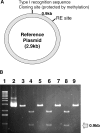Four new type I restriction enzymes identified in Escherichia coli clinical isolates
- PMID: 16040596
- PMCID: PMC1178010
- DOI: 10.1093/nar/gni114
Four new type I restriction enzymes identified in Escherichia coli clinical isolates
Abstract
Using a plasmid transformation method and the RM search computer program, four type I restriction enzymes with new recognition sites and two isoschizomers (EcoBI and Eco377I) were identified in a collection of clinical Escherichia coli isolates. These new enzymes were designated Eco394I, Eco826I, Eco851I and Eco912I. Their recognition sequences were determined to be GAC(5N)RTAAY, GCA(6N)CTGA, GTCA(6N)TGAY and CAC(5N)TGGC, respectively. A methylation sensitivity assay, using various synthetic oligonucleotides, was used to identify the adenines that prevent cleavage when methylated (underlined). These results suggest that type I enzymes are abundant in E.coli and many other bacteria, as has been inferred from bacterial genome sequencing projects.
Figures




Similar articles
-
Quick identification of Type I restriction enzyme isoschizomers using newly developed pTypeI and reference plasmids.Nucleic Acids Res. 2008 Aug;36(13):e81. doi: 10.1093/nar/gkn056. Epub 2008 Jun 18. Nucleic Acids Res. 2008. PMID: 18562466 Free PMC article.
-
The recognition and modification sites for the bacterial type I restriction systems KpnAI, StySEAI, StySENI and StySGI.Nucleic Acids Res. 2004 Jun 15;32(10):e82. doi: 10.1093/nar/gnh079. Nucleic Acids Res. 2004. PMID: 15199175 Free PMC article.
-
The type I restriction endonuclease R.EcoR124I: over-production and biochemical properties.J Mol Biol. 1996 Apr 19;257(5):977-91. doi: 10.1006/jmbi.1996.0217. J Mol Biol. 1996. PMID: 8632480
-
[Antirestriction proteins ardA and Ocr as effective inhibitors of the type I restriction-modification enzymes].Mol Biol (Mosk). 2009 Mar-Apr;43(2):264-73. Mol Biol (Mosk). 2009. PMID: 19425495 Review. Russian.
-
Defining domains in type-I restriction and modification enzymes.Gene. 1988 Dec 25;74(1):239-41. doi: 10.1016/0378-1119(88)90295-8. Gene. 1988. PMID: 3074012 Review. No abstract available.
Cited by
-
Characterization of a restriction modification system from the commensal Escherichia coli strain A0 34/86 (O83:K24:H31).BMC Microbiol. 2008 Jun 27;8:106. doi: 10.1186/1471-2180-8-106. BMC Microbiol. 2008. PMID: 18588664 Free PMC article.
-
Type I restriction enzymes and their relatives.Nucleic Acids Res. 2014 Jan;42(1):20-44. doi: 10.1093/nar/gkt847. Epub 2013 Sep 24. Nucleic Acids Res. 2014. PMID: 24068554 Free PMC article. Review.
-
Quick identification of Type I restriction enzyme isoschizomers using newly developed pTypeI and reference plasmids.Nucleic Acids Res. 2008 Aug;36(13):e81. doi: 10.1093/nar/gkn056. Epub 2008 Jun 18. Nucleic Acids Res. 2008. PMID: 18562466 Free PMC article.
-
Single-nucleotide-resolution sequencing of human N6-methyldeoxyadenosine reveals strand-asymmetric clusters associated with SSBP1 on the mitochondrial genome.Nucleic Acids Res. 2018 Dec 14;46(22):11659-11670. doi: 10.1093/nar/gky1104. Nucleic Acids Res. 2018. PMID: 30412255 Free PMC article.
References
-
- Bullas L.R., Colson C., Van Pel A. DNA restriction and modification systems in Salmonella. SQ, a new system derived by recombination between the SB system of Salmonella typhimurium and the SP system of Salmonella potsdam. J. Gen. Microbiol. 1976;95:166–172. - PubMed
-
- Murray N.E. 2001 Fred Griffith review lecture. Immigration control of DNA in bacteria: self versus non-self. Microbiology. 2002;148:3–20. - PubMed
Publication types
MeSH terms
Substances
LinkOut - more resources
Full Text Sources
Other Literature Sources
Molecular Biology Databases

